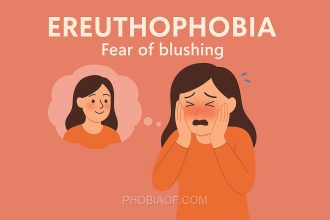Have you ever felt an overwhelming sense of dread at the thought of crossing a busy street? If so, you might relate to those who experience agyrophobia, a specific phobia that can make the simple act of crossing roads a daunting challenge.
Agyrophobia is the fear of crossing streets, a condition that can significantly impact daily living. The term “agyrophobia” is rooted in the Greek words “agora,” meaning marketplace, and “phobos,” meaning fear. Although agoras were originally places where people gathered, the term has evolved, and in this context, it reflects the fear associated with crossing bustling streets and intersections.
Individuals with agyrophobia may experience intense anxiety, panic attacks, or an overwhelming feeling of dread when faced with the prospect of crossing roads. This fear can affect people in various ways:
- They might avoid busy urban areas altogether, limiting their social interactions and opportunities.
- Some may go out of their way to find alternative routes that bypass streets, even if it means taking a longer path.
- Others might rely heavily on friends or family for accompaniment when they need to navigate through traffic.
Understanding agyrophobia is the first step towards compassion and support for those who face this fear daily. While it might seem like an unusual phobia to some, for those affected, it is a real and challenging aspect of their lives.
Causes of Agyrophobia
Agyrophobia, the fear of crossing streets, can be a debilitating condition for those who experience it. Understanding its causes can help in managing this phobia effectively. Several factors may contribute to the development of agyrophobia, ranging from genetic influences to environmental triggers.
Genetic Predisposition
One potential cause of agyrophobia is a genetic predisposition. Research suggests that phobias can run in families, indicating a hereditary component. If a close relative has a specific phobia, it may increase the likelihood of another family member developing a similar fear.
Traumatic Experiences
Traumatic experiences involving streets or traffic can lead to agyrophobia. For instance, witnessing or being involved in a serious accident can create a lasting fear of crossing streets. This fear can be exacerbated if the incident was particularly distressing or if it resulted in injury.
Learned Behavior
Another factor is learned behavior from others. Children may develop agyrophobia if they observe parents or caregivers expressing intense fear or anxiety about crossing streets. This observational learning can instill a similar fear in the child, even if they have not experienced any direct trauma themselves.
Psychological and Environmental Factors
Psychological factors such as anxiety disorders can also contribute to agyrophobia. Individuals with a propensity for anxiety may find the unpredictability of traffic overwhelming. Environmental factors, like living in a busy city with heavy traffic, can further intensify the fear.
Interesting Theories and Research
Some researchers have proposed that agyrophobia might be linked to an evolutionary survival mechanism, where a heightened sense of caution around dangerous situations, like crossing busy roads, is a protective trait. However, when this caution becomes excessive, it can manifest as a phobia.
Understanding these potential causes is crucial for addressing agyrophobia. Therapy and interventions can be more effective when tailored to the individual’s specific experiences and background.
Symptoms of Agyrophobia
Agyrophobia, the intense fear of crossing streets, can manifest in various ways, affecting both the mind and body. Individuals with this phobia experience overwhelming anxiety that can significantly impact their daily lives. Here are some common symptoms:
- Intense Fear: A person with agyrophobia feels an overwhelming sense of fear or dread at the thought of crossing streets.
- Panic Attacks: Episodes of panic may occur, characterized by a sudden onset of intense fear or discomfort.
- Sweating: Experiencing excessive sweating, especially when approaching or thinking about crossing a street.
- Rapid Heartbeat: The heart may race uncontrollably, adding to the feeling of panic.
- Shortness of Breath: Individuals might feel they cannot catch their breath, leading to heightened anxiety.
- Nausea: Feeling sick to the stomach when faced with the prospect of crossing streets.
- Trembling or Shaking: Physical shaking or visible trembling may occur due to fear.
- Avoidance: A strong urge to avoid crossing streets, even if it means taking longer routes or staying indoors.
- Overwhelming Dread: Persistent thoughts and concerns about potential danger related to crossing streets.
These symptoms can severely interfere with daily life, making routine activities challenging or even impossible if the phobia is severe.
Treatment for Fear of Crossing Streets (Agyrophobia)
Overcoming agyrophobia, the fear of crossing streets, is possible with time, patience, and the right strategies. It’s important to remember that this phobia can be effectively treated and managed, allowing you to regain confidence in daily activities. Let’s explore some proven treatment options and coping strategies that can help you on this journey.
Therapies for Agyrophobia
- Exposure Therapy: This approach involves gradually facing your fear in a controlled and safe manner. By slowly increasing exposure to crossing streets, you can desensitize yourself to the fear, making it more manageable over time.
- Cognitive-Behavioral Therapy (CBT): CBT helps in changing the fearful thoughts associated with crossing streets. By identifying and challenging irrational beliefs, you can develop healthier thought patterns and improve your responses to anxiety-provoking situations.
- Counseling: Speaking with a trained counselor or therapist can provide you with support and guidance. Counseling can help you understand the root causes of your phobia and develop personalized strategies to overcome it.
Self-Help Coping Techniques
- Relaxation Exercises: Techniques such as deep breathing, progressive muscle relaxation, or visualization can reduce anxiety symptoms and promote calmness.
- Meditation: Regular practice of meditation can help improve your ability to manage stress and increase your overall sense of well-being.
- Support Groups: Joining a support group can connect you with others who are experiencing similar challenges. Sharing experiences and coping strategies can be empowering and comforting.
Medication
In some severe cases, medication such as anti-anxiety medications might be considered to help manage symptoms. However, it’s essential to focus on therapy and coping skills as the primary means of treatment.
If your fear of crossing streets is interfering with your daily life, it’s crucial to seek professional help. A mental health professional can guide you through the treatment process and help you regain control. Remember, you are not alone in this journey, and with the right support, you can overcome agyrophobia.
Conclusion
Understanding the causes and symptoms of agyrophobia is a crucial step in empowering individuals to address this often debilitating fear. By recognizing the underlying factors and how they manifest, those affected can begin to take proactive steps towards overcoming their phobia. Knowledge is a powerful tool, and with it, individuals can demystify their fears and take control of their lives.
It is important to remember that many people have successfully managed or even overcome their phobias with time and appropriate support. With patience, persistence, and the right strategies, you too can find a path toward improvement. While the journey may be challenging, it is also filled with opportunities for growth and resilience.
If you find that your fear of crossing streets significantly impacts your daily life, consider seeking professional help. Talking to a doctor or engaging in therapy can provide you with the necessary tools and support to manage your phobia effectively. Know that you are not alone, and help is always within reach.
With understanding, support, and a willingness to seek help, there is every reason to remain hopeful and optimistic about managing agyrophobia. Embrace the journey to overcoming your fears, and remember that each step, no matter how small, is a step towards a more liberated and fulfilling life.






